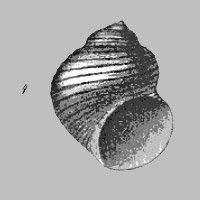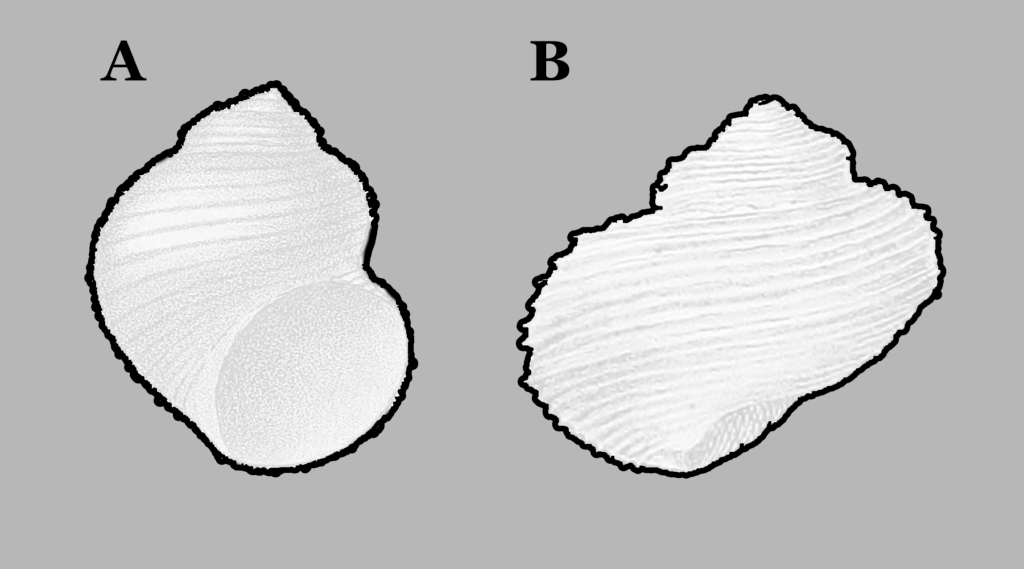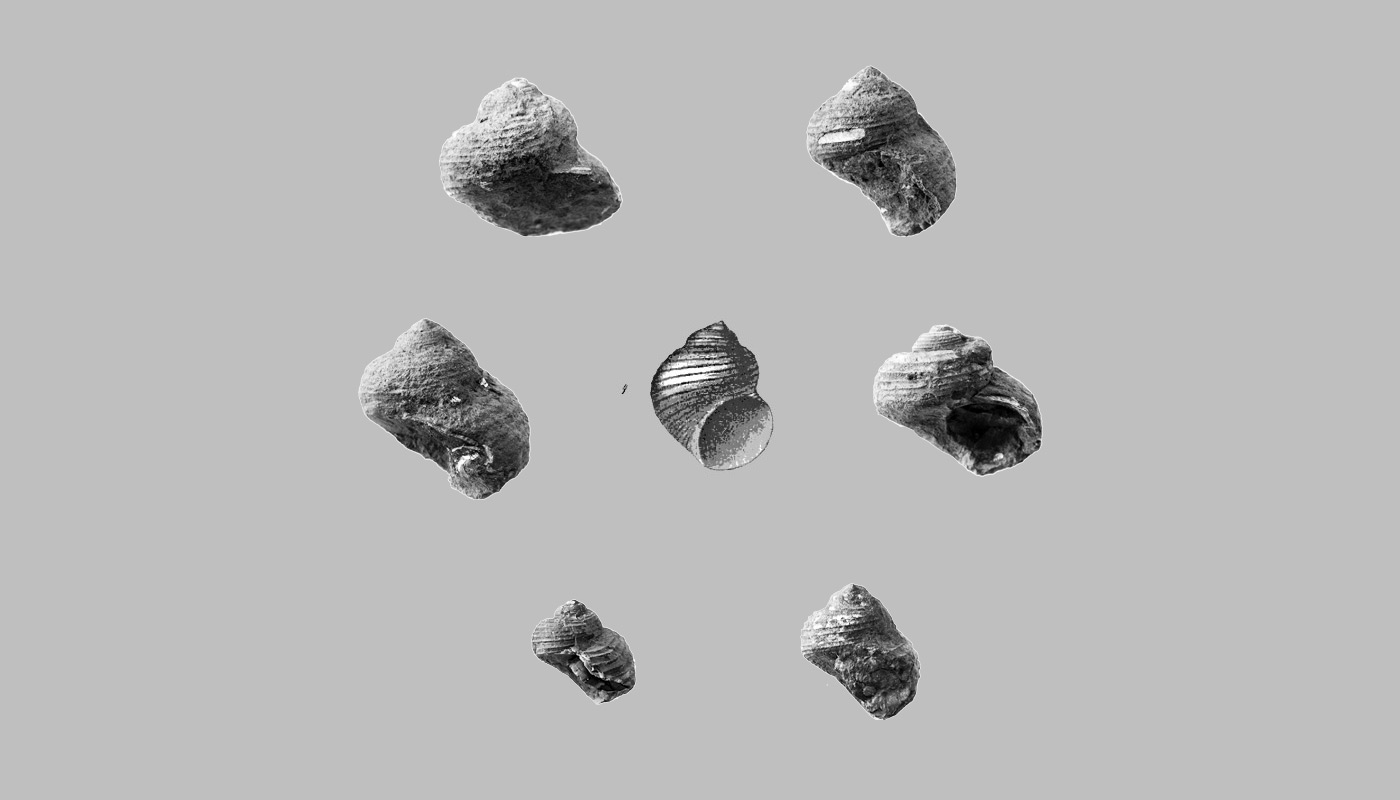
Timothy Conrad’s description of the Paleozoic gastropod Turbo insectus in 1835 was an open-and-shut case. He described and figured a new species of the genus Turbo in his historical, single-sentence description. His was the first report of North American marine fossils of the Pennsylvanian age. Unfortunately, this was also the final report of T. insectus itself, with no future author describing recovered specimens as this species, at least with evidence.
In 1855, Joseph Norwood and Henry Pratten of the Illinois Geological Survey published a report on eight new species of Carboniferous fossils. In their report, they designated Pleurotomaria carbonaria as a new species. Either Norwood and Pratten did not know about Turbo insectus or did not think it was related. Either way, this was not mentioned in their text, a report of specimens from Illinois that were said to be rare to find at the locality.
It’s hardly surprising that authors ignored Turbo insectus. Even if the authors of P. carbonaria had reviewed Conrad’s illustration, it had problems. Had Conrad drawn his original illustration from a specimen of what is now known as Shansiella carbonaria, it was either misshapen or poorly illustrated. In Figure 1, you can see the difference in outline between the two. Several authors have compared the two over the years. Each of them has suspected that the two might be the same species.

The discovery of Turbo insectus by Edward Miller
Edward Miller, an assistant railway engineer, recovered the specimen of Turbo insectus. While employed in constructing the Allegheny Portage Railroad, he spent his leisure time examining the rocks in the area. Using large excavating equipment to clear room for the infrastructure needed to lift railcars over the Allegheny Mountains exposed the hidden underlying geology. As an engineer rather than a geologist, Miller gave his fossils to well-known paleontologists and paleobotanists of the day to describe and illustrate them.
In Timothy Conrad’s paper, he reported other new species recovered from the same stratum. This greatly helps the case of possibly correlating T. insectus with S. carbonaria, as the report included familiar Pennsylvanian marine fossils from the same location. Two are still valid species today, the well-known gastropods Worthenia tabulate (called Turbo by Conrad) and Strobeus primogenius (which Conrad called Stylifer).
Photography was uncommon for much of anything in 1835, let alone for documenting recovered fossils. Conrad published the specimens given to him by Miller using drawings. Today’s standard practice for naming a new species is to describe and illustrate it thoroughly. Also, an author deposits the holotype specimen in an institution that allows others to review it. A manuscript containing a name, description, figure, identification number for the holotype, collection location, and the name of the formation in which it occurred is all part of the process. It’s essential to be accurate and to ensure you are not describing an undeclared species.
Collecting standards from 1835 are not the same as the ones used today. Nobody knows where the specimen is today, perhaps retained by Conrad, Miller, or presented to a friend after publication. The authors could have transferred it within their families or simply tossed it out later. It is all speculation. As far as science knows, Conrad’s new gastropod species, Turbo insectus, appeared and disappeared in 1835. Since the specimen is missing, any official correlation with other fossils is very difficult to establish.
The International Commission on Zoological Nomenclature (ICZN), the world authority on taxonomic naming rules, would not exist for another sixty years.
Four Authors Make a Correlation with T. insectus and S. carbonaria
The following four outstanding authors have commented on the speculated similarity of these two published species. Their writings in 1910, 1937, 1964, and 2016 have maintained that these two species are possibly the same.
Percy E. Raymond was the first curator of invertebrate fossils at the Carnegie Museum of Natural History and later chief paleontologist for the Geological Survey of Canada (Harper, 2016). George H. Girty was a top paleontologist working for the USGS in his time and known for his thorough work. Myron T. Sturgeon was a lifetime Pennsylvanian period researcher, producing several publications on the Pennsylvanian fossil fauna in Ohio. Finally, John A. Harper is a retired geologist for the Pennsylvania Geological Survey and noted expert in Mississippian period gastropods, writing several manuscripts about the class Gastropoda.
Percy E. Raymond mentions Turbo insectus
Percy E. Raymond published a list of fossil fauna for the Allegheny Formation and Conemaugh Group in Western Pennsylvania. In his research, he referenced Conrad’s report as part of his work. Raymond (1910, p. 145) wrote, “These first fossils, described by Conrad in 1835, are Turbo tabulata (Worthenia tabulata), Stylifer primogenia (Sphaerodoma primogenia), and Turbo insectus, a shell similar to, if not the same as Pleurotomaria carbonaria” in his discussion about the Brush Creek limestone. You can find Raymond’s photograph of P. carbonara in Figure 2-C.

George H. Girty Believes the Pair to be Congeneric
Girty’s comparison of T. insectus and P. carbonaria came in 1937. Yin had only recently coined the name Shansiella, so P. carbonaria was not yet reassigned to that genus. Girty’s discussion was similar to Raymond’s, a quick sentence comparing the two, giving a solid suggestion that the two were the same, or at the very least, belonged under the same genus.
Oddly enough, Girty referenced Turbo insectus as Pleurotomaria insecta, but I know of no publication where an author reassigned T. insectus to this genus. “The same is equally, or even more true of P. insecta, which Conrad described under the genus Turbo, but which I can scarcely doubt is a species at least congeneric with P. carbonaria.” (Girty, 1937, p. 211). It seems that Girty adjusted the name as well. He used insecta instead of insectus, but this was to match the gender of the genus, a required practice with Latin names.
Myron T. Sturgeon Proposes a Solution for Turbo Insectus
In his review of 40 specimens of Shansiella carbonaria from the Putnam Hill and Vanport limestones of eastern Ohio, Sturgeon ended his remarks with a paragraph on the similarity of Turbo insectus with Shansiella carbonaria. His was the most prolonged discussion on the matter. He states, “In 1835 T. A. Conrad (p. 267, pl. 12, fig. 4) named, crudely figured, and briefly described a gastropod species as Turbo insectus from the Brush Creek Member near Bens Creek, Pennsylvania. Conrad’s figure of T. insectus resembles Shansiella carbonaria, a fact that Raymond (1910, p. 145; 1911, p. 85) has already noted. If topotype material should eventually prove T. insectus and S. carbonaria to be the same, Conrad’s name has precedence over Norwood & Pratten’s, and the name of this species will have to become S. insectus (Conrad).” (Sturgeon, 1964, p.210).
He proposed a path for resolving the name. If workers recovered good Shansiella carbonaria material from the Ben’s Creek locality, Shansiella carbonaria would become Shansiella insectus.
However, Sturgeon wrote this in 1964. It’s been 56 years since his writing, and 185 years since Conrad published his inadequate description and illustration. The species S. carbonaria is 165 years old, written about in numerous publications, and labeled as such in several museum collections. Changing the name at this point could be counterproductive and confusing, so at least someone would likely object to this change in modern times.
John A. Harper’s Manuscript about the First Pennsylvanian Marine Invertebrate Fossil Locality in North America
John A. Harper has been an incredible resource for me to learn about local fossils, especially invertebrates in the Glenshaw Formation. His 2016 paper about the historic Ben’s Creek locality is the most comprehensive review. He writes about the economic history and the geologic setting, reviews each of Conrad’s fossil finds, and discusses finds by three authors, Conrad, Raymond, and Leidy.
Harper’s review is essential as he clearly states that Conrad’s illustration shares no similarities to any other Pennsylvanian gastropod from North America. Harper has long written about gastropods and specializes in Mississippian gastropods; however, he has spent most of his time living and working overtop of Pennsylvanian age rocks. He has written papers on several finds in the Glenshaw Formation, including the first Pennsylvanian-aged report of a cephalopod aptychus in the Appalachian Basin.
The work is also crucial as it correlates with the other associated finds that Conrad, Raymond, and Leidy made at the location, placing Turbo insectus in the company of other fossils commonly found with Shansiella carbonaria. Harper’s plate in the article, Figure 7, directly compares each author’s illustration to modern photographed specimens. “Turbo insectus (Figure 7C) has not been described, illustrated, or documented since Conrad’s original report. Given that Conrad’s lithographs are probably fairly accurate, it is possible that it was based on a distorted specimen of Shansiella carbonaria (Norwood and Pratten) (shown on the right in Figure 7C for comparison). Shansiella, like Worthenia, is one of the more recognizable fossils found in Pennsylvanian marine faunas throughout North America. I know of no other Pennsylvanian gastropod from North America that comes even close to Conrad’s illustration of Turbo insectus.” (Harper, 2016, p. 9).
Conclusion
It is no secret that the nomen dubium Turbo insectus is possibly the same fossil as Shansiella carbonaria. All published authors have considered the possibility of correlation, showing that the two might be the same species. The problems still exist. There is a distorted illustration and a missing specimen. But, with time comes difficulties. Since the issues have been unsolved for a long time, and researchers have not recovered published material from the location for over 100 years, it seems that species synonymization may be impossible. Sturgeon suggested a path for fixing the problems, but it may now be too late.
References
- Conrad, T.A., 1835, Description of five new species of fossil shells in the collection presented by Mr. Edward Miller to the Geological Society: Geological Society of Pennsylvania Transactions, v. 1, pp. 267–270
- Girty, G.H., 1937, Three Upper Carboniferous Gastropods from New Mexico and Texas, Journal of Paleontology, Vol 11, No 3, pp 202-211.
- Harper, J.A., 2016, North America’s First Pennsylvanian Marine Invertebrate Fossil Locality, Geology, v. 46, no. 4, pp. 3–14
- Miller, E., 1835, Geological description of a portion of the Alleghany Mountains, illustrated by drawings and specimens: Transactions of the Geological Society of Pennsylvania, v. 1, pp. 251–255.
- Morningstar, H., 1922, Pottsville fauna of Ohio. Ohio Geological Survey, Bulletin 25 pp. 1-312
- Norwood, J.G., and Pratten, H., 1855, Notice of fossils from the Carboniferous Series of the western states belonging to the genera Spirifer, Bellerophon, Pleurotomaria, Macrocheilus, Natica, and Loxonema, with descriptions of eight new characteristic species. Journal of the Academy of Natural Sciences of Philadelphia 3: pp. 71-77
- Raymond, P.E., 1910, A preliminary list of the Fauna of the Allegheny and Conemaugh Series in Western Pennsylvania, Annals of the Carnegie Museum, pp. 144-158
- Sturgeon, M.T., 1964, Allegheny Fossil Invertebrates from Eastern Ohio: Gastropoda. Journal of Paleontology, 38(2), pp. 189-226

